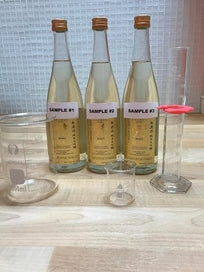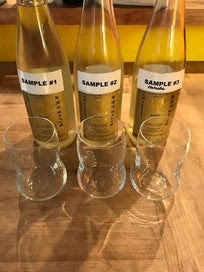Sake Experiment – Born Three Ways!

Over the past decade we have done a lot of what we call “sake experiments,” at True Sake. Are we scientists? No! Are we sake makers? Nope! Then what in the heck are we, and who cares about our experiments? We are you! We are the “end users.” We are the folks who are at the end of the line in the sake making, shipping, distributing scenario, and quite frankly we are the most important stop! The entire process operates for us! Therefore we play around with sake from our perspective as the end user and ultimate consumer.
We have done lots of experiments having to do with the movement, storage, aging, and consumption of sake. As retailers, we have access to the goods, and it behooves us to know the strengths and limitations of sake. Temperature, storage, vibration, oxidation, caps, and vessels... we pretty much have done it all. And by all means ask our distributors, importers, and the brewers themselves what they have learned from us for the past 15 years. I think the scientific term is “a lot.”
Many of our little experiments originate from our customers when they ask certain questions, “Once I open a bottle how long can I keep it in the fridge?” “Do I have to keep it in the fridge?” “Do I need to decant sake?” etc. And just like in life there are no stupid questions. We take them all very seriously and we want to provide the best and most “scientific” response possible, so we can say things like “No you don’t need to decant sake, this Junmai Ginjo actually drinks better the second day that it has been opened.”
This month when the True Sake Team got together we tasted an experiment that was months in the making. We wanted to test how well the same sake did stored opened in the fridge and stored open on the room temperature shelf for 5 months. On March 15, 2017 Mei and KJ opened one bottle of Born Gold and poured half into another empty bottle and capped it. And then we started the storage experiment.

Sample #1 was a “fresh” full bottle of Born Gold Daiginjo bottle dated 2016.10 stored in the refrigerator. Sample #2 was a half bottle of Born Gold Daiginjo bottle dated 2016.10 and stored in the refrigerator. Sample #3 was a half bottle of Born Gold Daiginjo bottle dated 2016.10 and stored at room temperature.
On Saturday September 2nd we tested the brews. But rather than just taste we challenged the Team to see if they could tell the three samples apart. And yes they did very well! And so too did the sakes. Herewith are the “results” for the three sakes stored in three different capacities.
SAMPLE #1 (stored in fridge closed) This was basically the “Basis” sake as it was the bottle that was unopened and stored properly in the fridge. Of course it drank smooth and fresh with layers or gentle fruit tones. The fluid was velvety and had more impact than the other two samples. Fresh and clean and noticeably lighter than the other two samples.
SAMPLE #2 (stored in fridge half-bottle opened) This sample had some subtle signs of oxidation, but the overall drinkability was very similar to the un-opened bottle. It was a little rounder than the “Basis Sample” and had more of a relaxed feeling. It wasn’t more watery, but the flavor condensed upon itself a little and it was more slippery. There was also a little hint of heat in the tail, but this sample did not drink poorly or was undrinkable. Did the oxidation improve the flavor? Not really, but the slightly diminished version was also not a distraction or noticeably a bad sake.
SAMPLE #3 (stored on room temperature shelf half-bottle opened) This sample had a nose give-away that it was slightly aged with a subtle change to more rich, caramelized aromas rather than the fresh nose. It was more watery and soft than the other two samples. The sake drank smooth and very relaxed with a few more savory elements and almost creamy. But! This brew did not drink skunky or crappy. It didn’t drink like mud or heavy and hot. It was obviously a little different than the other two versions, but on its own it was just a little more watery and savory. Did we have to spit it out? Nope. Did we prefer it to the two fridge-stored samples? Nope! But it was nice to know that it didn’t taste like soy sauce!
Would you leave half a bottle of sake on your pantry shelf for almost 6 months? I doubt it! In your fridge? Well, that’s a little more likely. The good news is that the sake showed that it had some finesse and was up to the challenge of poor storage methods or misuse. If somebody were to abuse this Daiginjo then we feel pretty comfortable that it would hold its own. In fact, a new sake was born from the Born that we birthed!
